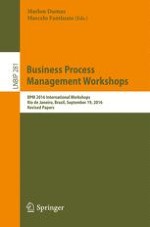This book constitutes the revised papers of the ten international workshops that were held at BPM 2016, the 14th International Conference on Business Process Management, held in Rio de Janeiro, Brazil, in September 2016.
The 36 papers included in this volume were carefully reviewed and selected from a total of 64 submissions. They are from the following workshops: BPI 2016 – 12th International Workshop on Business Process Intelligence; BPMO 2016 – 1st Workshop on Workshop on Business Process Management and Ontologies; BPMS2 2016 – 9th Workshop on Social and Human Aspects of Business Process Management; DeMiMoP 2016 – 4th International Workshop on Decision Mining & Modeling for Business Processes; IWPE 2016 – 2nd International Workshop on Process Engineering; PQ 2016 – 1st International Workshop on Process Querying; ReMa 2016 – 1st Workshop on Resource Management in Business Processes; PRAISE 2016 – 1st International Workshop on Runtime Analysis of Process-Aware Information Systems; SABPM 2016 – 1st International Workshop on Sustainability-Aware Business Process Management; TAProViz 2016 – 5th International Workshop on Theory and Application of Visualizations and Human-centric Aspects in Processes.
